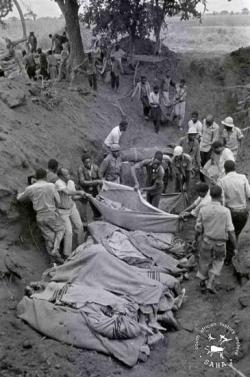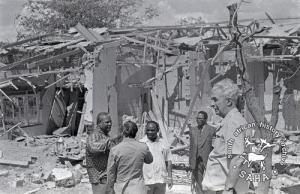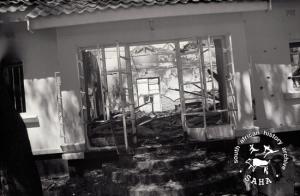 The attack on Mkushi Camp was not the only bold assault by the Rhodesian forces on ZAPU installations in Zambia. As the war intensified such attacks became a daily threat and a frequent occurrence, not only for the military staging and training camps in the Zambezi Valley, but also for the refugee camps, for administrative and military personnel housed in Lusaka, and for the transit camps. The attack on Nampundwe Camp in which several people died has been described by Cetshwayo Sithole and Benjamin Dube, Regina Ndlovu refers to threatened attacks on Victory Camp.
The attack on Mkushi Camp was not the only bold assault by the Rhodesian forces on ZAPU installations in Zambia. As the war intensified such attacks became a daily threat and a frequent occurrence, not only for the military staging and training camps in the Zambezi Valley, but also for the refugee camps, for administrative and military personnel housed in Lusaka, and for the transit camps. The attack on Nampundwe Camp in which several people died has been described by Cetshwayo Sithole and Benjamin Dube, Regina Ndlovu refers to threatened attacks on Victory Camp.
Mzila-Ndlovu refers to an attack on the training camp in Angola; the boys’ school at JZ Moyo Camp nearby was bombed and even after it moved far north to Zambia’s North-western province near Solwezi the children were subjected to bombardment again. Joshua Nkomo’s house in Lusaka was attacked from the ground and the air, the Liberation Centre was attacked on the ground and a house used by military intelligence was attacked by helicopter-borne paratroops. Nothing and nowhere was safe. However, by far the most devastating in terms of loss of life was the attack on Freedom Camp in October 1978, just at the same time as the Mkushi attack.
Photographs showing the damage caused by these assaults appear with great frequency in the Nkobi collection. Most relate to the Freedom Camp attack, and some to the attack on Nkomo's house, with only a few apparently showing the damage to Works Camp not far from Victory Camp. Joshua Nkomo's house was the subject of a direct night assault by a ground force using land rovers, and was simultaneously bombed from the air.
A fierce firefight took place in which several on both sides lost their lives, but Nkomo escaped, having received a tip-off from intelligence. No account of this attack emerged from the interviews here, but an interesting side event featured in Zephaniah Nkomo's story. At the time Zephaniah was an intelligence officer detailed to the security of the Presidency. The day before the attack on Nkomo, he had, during reconnaissance in the vicinity of Lusaka, come upon a white farmer painting land rovers in the colours of the Zambian police:
I sneaked to one white man along the farmland and this man had a farm along Aaron Milner’s farm. I sneaked in, armed, and went to see what was happening in this farm, where I found the owner of the farm, a white man, busy spraying land rovers and also doing a lot of mechanical work. I did not shoot him, but my intention of coming there was to carry out reconnaissance and make sure whatever decision would follow was to be supported by what I saw. I was instructed to move out when he saw me, having entered without permission in his premises I was at Makeni that night [of the attack]. It happened around 11 p.m. The whole town, Lusaka, was shaking with vibrations from bombs, shelling, shooting, the sound was just unbearable.
The following day we made our reconnaissance missions around Lusaka and some other suspected areas and we found and apprehended one suspect who confessed before us that he took part in Nkomo’s house bombing the previous night. I interrogated the man and he revealed astonishing information that they had come all the way from Rhodesia heavily armed, well equipped in a number of groups or units with specific tasks, and his task among other tasks was to capture him [Nkomo] alive or dead. Some were to capture material, some were armed with bazookas, all sorts of weapons that were fired and used in Nkomo’s house attack. Having interrogated this man we reported him to Joshua Nkomo who came and also interviewed him. After interviewing him he advised us or instructed us to take him and surrender him to the Zambian authorities.
Freedom Camp was located about 25 kilometers north of Lusaka. The party was using a farm in that area to produce food for the cadres as well as the refugees. But it was also frequently used as a transfer base when recruits were being sent for training out of the country.
On the day when it was attacked a large number of recruits were waiting for transfer to Angola. They had been assembled for a parade addressed by the commander Mangena, who had left, but they were still waiting to be dismissed.
Longman Ndebele was there, as was Christopher Moyo.
Moyo relates:
We saw a spotter plane hovering around. We thought that it was something .. Zambians, because it went just like that and came back and came again. That was for the second time. Then it was followed by jet .. jet fighters from Rhodesia. ..tho se Canberra and Mirage and things like that. Within some minutes there were about six or so planes were hovering over our head … It was just empty, very few trees you see. Then within a short time then air force just started bombing, bombing the whole camp, bombing … the people were crowded like this …it was a horrible thing.
Then people started running here and there and they couldn’t reach that place [the area protected by trees where they were sleeping]. So those people were just squeezed in the place and many of them were killed, … those planes were going around, when they come down the first thing they will open machines and sub-machines, something like that, then when they go up they will start dropping drums … dropping napalm over these people. … we were in the parade, so people were just in that … in that manner, so they started dropping … dropping napalms, dropping everything that they can do.
…there were helicopters again which came after some minutes af ter those airplanes they have done their job. Then the helicopters … about 6 to 9 ..6-9 yes, helicopters, start hovering again, shooting people now, using heavy machine guns. So people, those people who were trying to run away from the sector, then they were killed by helicopters … Because they were just going like this, just going around … around the camp…around the … whoever is trying to run away was killed. Trying to run away, was killed just like that.
Moyo was injured, but not seriously, so that after spending some time in hospital he was able to return to his unit and eventually departed for Angola for training, and later participated in the frontline. Longman Ndebele was not so lucky, as his injuries were more permanent:
I was already a company … logistic, I was hit when I was in the shed giving some other comrades some combats [uniforms]. So the other group of comrade s were at the parade and some of us were giving some combats to some of our colleagues who were there. Initially while in the shed he was injured on the arm, but that was just the beginning: When I came out here this building was already on fire, so inste ad of going this side, I went towards the parade, and before I … before I was just near the kitchen, where there’s an open space, that’s when I noticed four jet fighters coming, and by the time when I took the position, I was somehow blown up, for the bomb probably burned about three or five metres from me, then my foot was shattered.
He confirms Moyo’s story about the helicopters following the planes and trying to catch anyone who was escaping:
So by the moment when those planes had gone, there happened to be some helicopters at the side where I was … I think there were about three. They were the ones which went around shooting people who were trying to have a break-through, for those helicopters were trying to push people who were in the camp so that they could not come out and the planes could hit their target.
Many young recruits died that day, some from napalm burning and others from other cluster bombs or from shooting. The dead were buried there on the spot in mass graves. There was also considerable property damage which appears in several of the photographs.
After training Moyo experienced further bombing attacks at the camp where he was taken before being deployed into battle:
Then before going home [into the front] then we were taken to Mulungushi, it’s a ZPRA training camp. We stayed there for … three weeks and there, daily there was bombardment, in the morning when we were about to drink tea, there the planes were coming; there’s a dam somewhere nearer the camp. Then in the afternoon, but the time when you are going for the lunch, then the bombardment is coming. Around 5 somewhere the bombardment is coming and we were collecting fish, dead fish .. from the dam after … after the bombardment. We were just collecting dead fish from around there and we used the … we had those fish.
Ndebele, on the other hand, was too severely wounded ever to join the battle. He spent several months in hospital in Lusaka, and then was sent to Czechoslovakia to be fitted with an artificial limb. But they could not stay there indefinitely and eventually he was returned to Zambia into the care of ZAPU. It then became a problem for ZAPU of what to do w ith the now disabled, how to keep them profitably occupied, both to make some form of contribution and to avoid degeneration into depression:
So when I came home to Lusaka I… the first night I slept at Makeni, and when I was at Makeni we were told that we were to open a school at Kafue, so that’s the place where I stayed a bit longer. When we got to Kafue we opened a school for the disabled. So I was one of the teachers there, I was teaching other comrades, so we could even be driven to VC and to JZ where we could meet some other teachers there a nd make some drafts, they helped us with our books so we could help our comrades … e ven in their education. And one of the most pleasing things was that some of our comrades in their education … that most of our comrades whom we were teaching, some of them they had left home without even seeing the door of a school, so they were very pleased to get the chance of reading.




